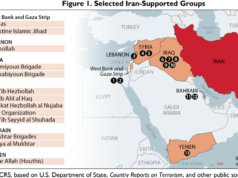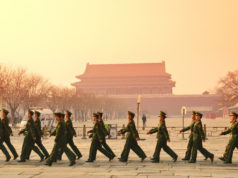[Editor’s Note: Guermantes Lailari is a member of the JPC Board of Fellows. In the Winter 2022 edition of InFocus Quarterly, he wrote that the South China Sea was the next target of the Chinese Communist Party (CCP) after Taiwan. This new article, based on information secretly recorded during a provincial level CCP-PLA meeting and posted online, argues that the CCP tasked the People’s Liberation Army (PLA) to take both Taiwan and the South China Sea simultaneously.]
On 14 May 2022, a war mobilization board meeting of the Guangdong Standing Committee of the Provincial Communist Party Committee of China was secretly recorded and posted on the Internet. Jennifer Zhang, a human rights activist, posted the Chinese transcript and an English translation. This article analyzes one important aspect of the transcript—the Chinese Communist Party’s (CCP) and People’s Liberation Army’s (PLA) invasion plans of Taiwan and the South China Sea (SCS) focusing on their plans to use unmanned weapon systems.
Around the fifteen-minute time hack, the CCP leaders assigned the following types and quantities to the Mobilization Tasks of Guangdong Province:
“One, the mobilization tasks issued to our province by the eastern and southern war zones [referring to the PLA Eastern and Southern Theater Commands] … with a total of 140,000 personnel, 953 ships of various types, and 1,653 units/sets of various unmanned equipment…64 10,000-ton roll-on/roll-off ships, 38 aircraft, 588 train cars and 19 civil facilities including airports and docks…
“First, to offer full support for the decisive battle at the Taiwan Strait…In particular, we should mobilize and expropriate all sea and air transport capacity to protect the across sea cooperation of troops, to ensure that the island seizing troops can get across the sea, and more troops can follow to seize the island.
“Second, to support the distant cruise. We will basically organize new-style ocean-going forces … outside the first island chain…
“Third, to participate in the South China Sea … transport forces to assist … the organization of militia fishing boats to respond to the infringement of the Vietnam, Philippines and Malaysia and other countries, to fight well the people’s war at sea.”
The list provides an important insight into their invasion plans although we do not know what tasks the CCP and the PLA assigned other provinces.
Key Points
The document explains the roles and responsibilities of the Guangdong civilian and military leadership. There should be no doubt that the CCP plans to take Taiwan and the SCS at the same time. The translated document clearly states that the CCP is conducting on-going military and civilian exercises that prepare for the invasion at all levels.
The list provides useful intelligence that an adversary can use for targeting. For example, the list states that “64 10,000-ton roll-on/roll-off ships” are assigned for the task. A military targeteer would ensure that they know where the tasked 64 RO/RO ships are for weaponeering.
Attack: Phase I Unmanned Equipment
The plan proposes using 1,653 unmanned systems to deplete the Taiwanese military’s defensive weapon systems during the initial stages of the invasion.
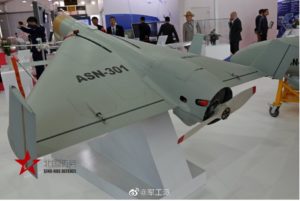
Phase I: Blind Taiwan’s military
The PLA will use precision guided missiles (ballistic and cruise), such as the PLA’s ASN-301 (anti-radiation loitering munition) and similar unmanned systems, to deny the ROC military an air and sea picture. This portion of the PRC attack will destroy all radars, including the Surveillance Radar Program (SRP) long-range radar as well as air, sea, ground, and missile defense associated radars.
Phase I: Attrit ships, aircraft, armor and anti-ship, anti-air, and anti-missile system
PLA intends to use unmanned systems to attrit Taiwanese navy ships and aircraft. The PLA navy will use these unmanned ships to clear a path against Taiwan navy countermeasures against ships. For example, the ROC Navy plans to deploy sea mines against the PLA Navy. The PLA Navy will sacrifice unmanned ships to allow troop carriers to transit the Taiwan Straits unopposed. Furthermore, the PLA Navy’s unmanned ships will also be used to absorb air-, sea-, and ground-launched anti-ship missiles. While the ROC military launches these countermeasures, the PLA military will use the detected launch sites on the ground, in the sea, and in the air to conduct counter attacks to attrit remaining anti-ship systems. The PLA’s end goal is to minimize threats to their invading forces.
Phase I: Destroy military bases, weapon storage areas, and other targets
The leaked classified briefing reveals that in the invasion’s first phase the PLA intends to overwhelm Taiwan’s defensive systems with 1,653 unmanned systems launched from Guangdong. PLA Rocket Forces will launch missile attacks against all known military targets such as weapon storage areas, and all ROC air, navy, and army bases will be targeted by more than one thousand precision guided missiles (ballistic and cruise). Political targets could also be part of the PLA plan.
Phase I: Grab the SCS Islands simultaneously
The PLA will also destroy radar sites in the SCS that protect islands of the Philippines, Vietnam, Brunei, Malaysia, Indonesia, and Taiwan. The PLA plans to take Taiwan’s islands in the SCS (Pratas and Spratly islands) and in the East China Sea (Penghu, Kinmen, Matsu, Wuqiu, Tungsha/Donsha, and Nansha islands). The classified list of weapons and people are sourced ONLY from Guangdong Province; we can assume that other provinces, such as Fujian and Hainan, are tasked to provide additional resources.
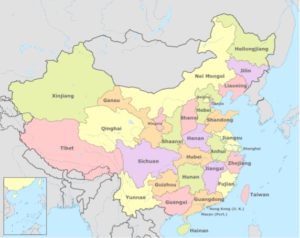
Taiwan and Penghu will become a part of a new province called Taiwan Province. Fujian Province would take control of Taiwan’s Kinmen, Matsu and Wuqiu islands, Guangdong Province will manage Taiwan’s Donsha island, and Hainan Province will administer Taiwan’s Nansha.
PLA Military Regional Commands
The 2021 DOD report on China states “the Eastern Theater Command is oriented toward Taiwan and the East China Sea.” 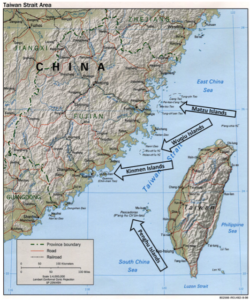
Other provinces in the Eastern Command are likely tasked with providing resources to the fight. For example, coastal provinces north of Guangdong such as Zhejiang, Shanghai, Jiangsu, and Shandong contain military resources that could enhance the success of the PLA operations against Taiwan by supporting a blockade or embargo of aircraft or shipping from Japan, South Korea, Guam, and the Western Pacific (US 7th Fleet) that attempt to interfere in Taiwan-SCS operations.
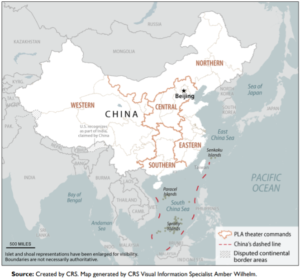
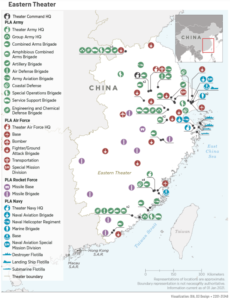
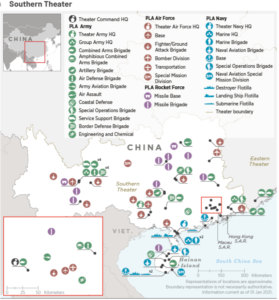
Based on the above analysis, the PLA has an opportunity after blinding and destroying a significant amount of the Taiwanese military capacity, to pause before the actual invasion to offer Taiwan an opportunity to surrender. If the PLA can conduct its operations quickly, Taiwan’s allies, such as the US and Japan, would not be able supply military aid or military forces before the PLA has forces on the ground in Taiwan.
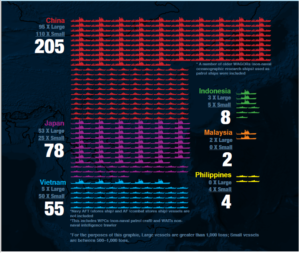
The SCS would be much easier to take over than Taiwan; only a few of the SCS islands have significant military personnel deployed to them from any of the claimant countries. Some of the claimant countries could try to use their military to stop the PLA, but without US and allies’ support, they would most likely lose.
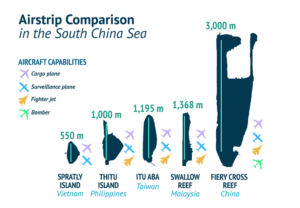
- Taiwan: Itu Aba Island (Spratly)
- Vietnam: Spratly Island and built defensive positions on dozens of islands
- the Philippines: Thitu Island (Spratly)
- Brunei: None
- Malaysia: Swallow Reef
- Indonesia: Natuna Besar Island
Will the US Defend Filipino SCS Islands?
The Philippines is the only country in the SCS that has a U.S.-Philippines Mutual Defense Treaty (US-PMDT) signed in 1951. The deterrent character of the treaty is compromised by some ambiguities (much like the US-Taiwan Relations Act), and President Roberto Duterte’s “separation” from the US policy. The US has been ambiguous in the past whether it would protect the Philippine islands in the SCS.
The U.S. could conduct continuous naval patrols and aerial freedom of navigation operations throughout the SCS, but these actions do not stop the PLA from occupying SCS islands. Absent a strong deterrent, the CCP could enforce national sovereignty ownership of the Nine-Dash Line area by establishing a new Air Defense Identification Zone (ADIZ) as well as publishing a military Notice to Airmen (NOTAM) declaring the area off-limits to all aircraft due to on-going military operations. The PLA could also declare the same for shipping and announce a maritime advisory.
Conclusion
Military and political analysts’ have emphasized defending Taiwan against a PLA attack by using competitive strategies to distract the PLA from being able to bring all of its resources to bear on Taiwan. In the case of the leaked secret meeting discussions, the PLA has developed a competitive strategy that forces the U.S. to deal with several security problems simultaneously—help Taiwan and prevent the PLA from taking over the SCS. In other words, the U.S. will have to divide its capabilities in two distinct areas which will diminish its combat effectiveness against the PLA that is exploiting short interior lines of communication.
The PLA has established air bases and ports throughout the SCS, and its ability to use the PLA Navy (over 340 ships), China Coast Guard (over two hundred ships) and the People’s Armed Forces Maritime Militia (over two hundred) and their ability to conscript the over 864,000 fishing vessels to reinforce actions, pose significant challenges to the US military to defend US friends and allies. The US also may be inhibited in adopting actions that could escalate a conflict into strikes against US bases in Japan, Guam, and possibly Hawaii.
To mitigate these attack scenarios, a build-up of U.S. military forces in countries willing to host them, such as Taiwan and the Philippines, should be begin soon to deter PLA actions against Taiwan and the SCS. The U.S. also should provide arms and combined training to countries willing to work with the U.S. and its allies. Japan, Australia, South Korea, Thailand, and the Philippines should activate their bilateral agreements to form the initial core of an alliance to deter and fight PLA encroachment in their territories. Finally, the US should make it clear by words and deeds that any attack on Taiwan and aggressive actions in the SCS will result in US military actions to defend its allies.
The good news is that the PLA is not ready today to take Taiwan and the SCS. For example, the PLA’s ability to use unmanned vehicles in “swarms” is several years behind that of the U.S. The bad news is that CCP and PLA have a plan to take Taiwan and the SCS as demonstrated by the secret Guangdong meeting’s transcript. The question is: what will the affected countries in the region and their allies do?
Volodymyr Zelenskyy, President of Ukraine, speech at the Shangri La Conference in Singapore on 11 June 2022 said it correctly for Taiwan and the SCS countries:
The world should help Taiwan “but it must be a preemptive way not the one that comes after the war has started after hostilities have” begun and “after we have hundreds of thousands of casualties and even millions of casualties like we have in Ukraine.”


